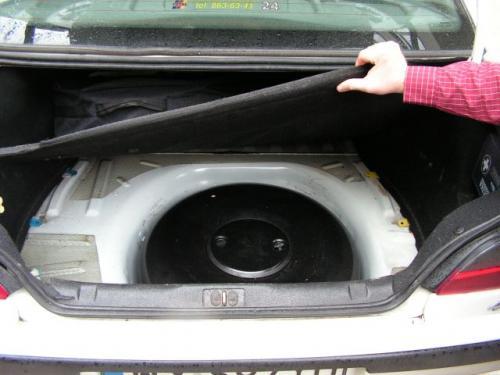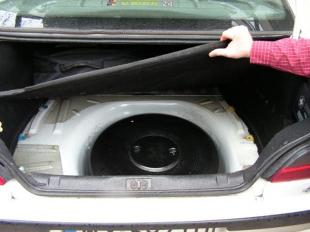
Fill the car
 We already have about 2 million gas vehicles in Poland. Rising gasoline prices are convincing more and more drivers to use this fuel.
We already have about 2 million gas vehicles in Poland. Rising gasoline prices are convincing more and more drivers to use this fuel.
Nobody is surprised by filling up a BMW or Jaguar with liquefied gas at a gas station. Well, everyone knows how to count, and by pouring propane-butane, we leave half the money on the counter than when refueling with ethylene.
LPG stands for Liquefied Petroleum Gas. The ratio of propane and butane in the mixture depends on the season of the year by providing an appropriate vapor pressure (which depends on the ambient temperature) - in winter (November 1 - March 31) in Poland a mixture with a higher propane content is used, and in summer the ratio is half.
The most notable advantage of LPG is the price – while a liter of petrol costs about PLN 4,30, a liter of gas filled into a car costs about PLN 2,02. “It's a by-product of crude oil refining,” says Sylvia Poplawska from the Coalition for Autogas. – Thus, the more expensive crude oil, the higher the price of gas at stations. Fortunately, this is not such a big change compared to  gasoline prices - when ethylene rises in price by a dozen or two pennies, liquefied gas by a few. Propane-butane is a seasonal fuel. During the heating period, its price usually increases by about 10%.
gasoline prices - when ethylene rises in price by a dozen or two pennies, liquefied gas by a few. Propane-butane is a seasonal fuel. During the heating period, its price usually increases by about 10%.
Gas is a more environmentally friendly fuel than gasoline - it is a combination of carbon and hydrogen without any other impurities. It creates a more homogeneous air-fuel mixture and burns completely even when the engine is cold. Exhaust gases are cleaner than gasoline - their main component is carbon dioxide, there is no lead, nitrogen oxides and sulfur. The engine is quieter because the gas has no detonation combustion.
There are also disadvantages
The car on gas is a little weaker. This effect is achieved not only in the most modern gas injection systems. The engine has a higher operating temperature, which results in faster cylinder head gasket replacement. You also need a place for the tank - so the trunk will be smaller, and if it is, for example, in place of the spare wheel, then it will have to be hidden somewhere.
When traveling abroad, do not forget to take special filling adapters with you, for example, to Germany, the Netherlands, Belgium, the UK and the Scandinavian countries, where infusions have different diameters.
The buyer of a car with a gas installation must ask the seller for a tank approval certificate - without it, he will not be able to pass the annual technical inspection.
In addition, some underground car park operators do not allow gas-powered vehicles to enter. “Of course they have a right to it,” the cap says. Witold Labajczyk, spokesman for the municipal fire department in Warsaw - However, in our opinion, there is no rational reason for such a ban.
Some people are afraid of a possible explosion of a gas tank in the event of a collision - I have not heard of such a case yet, - says Michal Grabowski from Auto-Gaz Centrum - A gas tank can withstand pressure several times higher than the pressure of the gas it contains.
Some accounts
If we decide to install a gas installation, let's check if it will be a financially profitable operation. You have to calculate the cost of gasoline used for the year and the cost of gas if we drove the same number of kilometers (note that gas consumption in liters is about 10-15% higher than that of gasoline). The difference in our “profit”, which now has to be compared with the price of the gas plant – after dividing the cost of the installation by the “profit”, we get the number of years it will take to recoup the cost of the gas plant. installation. This is the easiest way to calculate, because you also have to keep in mind the higher operating costs of a car running on gas - technical inspection costs more (PLN 114), an additional filter needs to be replaced (gas - about PLN 30) and the fact is that such a car requires more frequent replacement of spark plugs and ignition cables (at least once a year). In the case of vehicles equipped with 1,5 generation installations, it takes about XNUMX years to return the installation.
However, it is interesting to compare diesel with a gas-powered engine - it turns out that in a comparable car, the cost of diesel fuel used to travel 10 km is only slightly higher than the cost of gas, because diesels are usually economical. engines. If we take into account all the costs, it turns out that the installation of a gas installation is unprofitable.
Not for modern engines
The gas unit can be installed on almost any type of spark ignition engine - some workshops even install them on air-cooled cars. However, there are exceptions - gas supply to engines with direct fuel injection into the cylinder is not possible, says Michal Grabowski from Auto-Gaz Centrum. – These are, for example, Volkswagen FSI or Toyota D4 engines. In such cars, gasoline injectors will be damaged - after shutting off the fuel supply to them and switching to gas, they will not cool.
The gas installation can also be installed on new cars without voiding the warranty. General Motors (Opel, Chevrolet) allows this operation at its authorized workshops. Fiat recommends specific repair shops, while Citroen and Peugeot do not allow  installation of gas installations.
installation of gas installations.
Dealers also sell vehicles already installed, incl. Chevrolet, Hyundai, Kia.
Installation evolution
Installation types are conditionally divided into generations. The simplest so-called. The XNUMXth generation are designed for cars with carburetors or fuel injection without a catalytic converter. Gas in liquid form enters the reducer, where, when heated by liquid from the cooling system, it changes its state of aggregation to gaseous. Then his pressure drops. From there, it enters the intake manifold-mounted mixer, which adjusts its dose according to the engine's needs (i.e., adding or reducing "gas") so that the mixture provides the correct combustion process and optimal fuel consumption. Solenoid valves block the supply of gasoline or gas - depending on the choice of fuel.
Turning on and off the gas system can be done manually or automatically, and in addition, a gas level indicator or a switch can be installed in the tank, forcing you to drive only on gas or gasoline. Such an installation costs about 1100-1500 zł.
The second generation of the unit is designed for vehicles with fuel injection and a catalytic converter. The principle of operation is the same as that of the 1600th generation, except that it is equipped with electronics and software that controls the fuel-air mixture. The system collects information, including from the lambda probe, the number of engine revolutions and, based on them, controls the operation of the stepper motor, which regulates the gas supply to the mixer so that combustion conditions and exhaust emissions are as good as possible. The electronic emulator turns off the fuel supply to the injectors, it also has to “deceive” the car’s computer so that in such a situation it does not decide to switch to emergency engine operation (or completely prohibit movement). The cost is PLN 1800-XNUMX.
The XNUMXth generation installation differs from the XNUMXth in that the gas is supplied from the reducer to the proportioner and further to the distributor, and then to the individual engine intake ports, behind the intake manifolds. It is used in cars with plastic manifolds - sometimes the gas in the manifold ignites and the plastic element breaks. The units are equipped with electronic systems that perform the same function as in the XNUMXth generation.
The cost is approximately 1800-2200 thousand zlotys. “These are plants that are being used less and less,” says Michal Grabowski. “They are being replaced by more advanced and at the same time slightly more expensive sequential injection systems.
In the 2800 generation units, the expanded and volatile gas from the reducer is supplied to the nozzles located in each cylinder. The gas computer receives the data for the petrol injectors from the car computer and converts them into commands for the gas injectors. Gas is supplied to the cylinder simultaneously with gasoline in a correctly calculated dose. Thus, the operation of the unit is controlled by the on-board computer, which means that all its functions are saved (for example, mixture composition control, shutdown, etc.) The unit turns on automatically after the appropriate conditions are reached - coolant temperature, engine speed, gas pressure in the tank etc. In this system, the car retains all the technical parameters (acceleration, power, combustion, etc.), and the operation of the engine does not differ from that of gasoline. You have to pay PLN 4000-XNUMX for this.
The development of XNUMXth generation systems is the injection of liquid phase gas, i.e. XNUMXth generation. Here, the gas is fed into the cylinders like gasoline, in a liquid state. “These are expensive units and not very popular,” adds Grabowski. - The difference in engine performance compared to the fourth generation is minimal and you should not overpay.
Future for the KKE?
So will more and more vehicles be equipped with LPG installations? Not necessarily, because competition for propane-butane - CNG, i.e. compressed natural gas, such as we have in gas networks. It is even cheaper than liquefied petroleum gas – a liter costs about PLN 1,7. It is a completely natural product found in nature in large quantities - known resources are estimated at 100 years. Unfortunately, there are too few filling stations in Poland - less than 20 for the whole country, and the installation is quite expensive - about 5-6 thousand zlotys. There are still technological hurdles to overcome - in order to fill the right amount of gas, it must be highly compressed, which takes a long time and requires strong, and therefore heavy tanks.
However, there is hope - you can buy several models of cars with factory-equipped CNG systems (including Fiat, Renault, Honda and Toyota), and in the USA there is also a device for refueling a car in your own garage! Connected to the city network, the car's tank fills up all night.